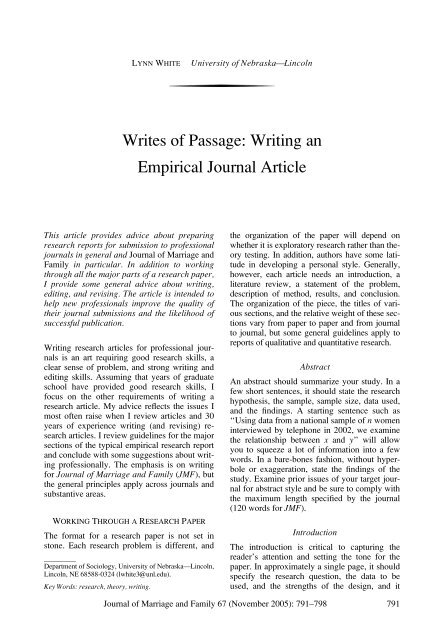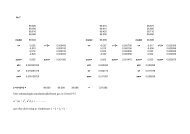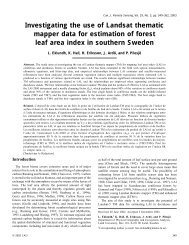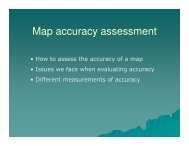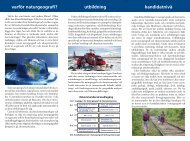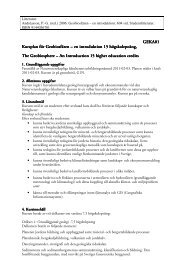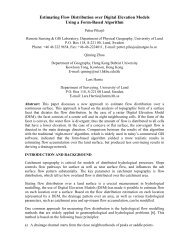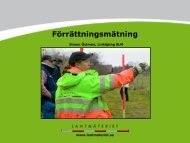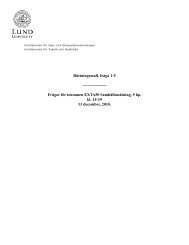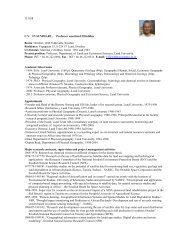Writes of Passage: Writing an Empirical Journal Article
Writes of Passage: Writing an Empirical Journal Article
Writes of Passage: Writing an Empirical Journal Article
You also want an ePaper? Increase the reach of your titles
YUMPU automatically turns print PDFs into web optimized ePapers that Google loves.
LYNN WHITEUniversity <strong>of</strong> Nebraska—Lincoln<strong>Writes</strong> <strong>of</strong> <strong>Passage</strong>: <strong>Writing</strong> <strong>an</strong><strong>Empirical</strong> <strong>Journal</strong> <strong>Article</strong>This article provides advice about preparingresearch reports for submission to pr<strong>of</strong>essionaljournals in general <strong>an</strong>d <strong>Journal</strong> <strong>of</strong> Marriage <strong>an</strong>dFamily in particular. In addition to workingthrough all the major parts <strong>of</strong> a research paper,I provide some general advice about writing,editing, <strong>an</strong>d revising. The article is intended tohelp new pr<strong>of</strong>essionals improve the quality <strong>of</strong>their journal submissions <strong>an</strong>d the likelihood <strong>of</strong>successful publication.<strong>Writing</strong> research articles for pr<strong>of</strong>essional journalsis <strong>an</strong> art requiring good research skills, aclear sense <strong>of</strong> problem, <strong>an</strong>d strong writing <strong>an</strong>dediting skills. Assuming that years <strong>of</strong> graduateschool have provided good research skills, Ifocus on the other requirements <strong>of</strong> writing aresearch article. My advice reflects the issues Imost <strong>of</strong>ten raise when I review articles <strong>an</strong>d 30years <strong>of</strong> experience writing (<strong>an</strong>d revising) researcharticles. I review guidelines for the majorsections <strong>of</strong> the typical empirical research report<strong>an</strong>d conclude with some suggestions about writingpr<strong>of</strong>essionally. The emphasis is on writingfor <strong>Journal</strong> <strong>of</strong> Marriage <strong>an</strong>d Family (JMF), butthe general principles apply across journals <strong>an</strong>dsubst<strong>an</strong>tive areas.WORKING THROUGH A RESEARCH PAPERThe format for a research paper is not set instone. Each research problem is different, <strong>an</strong>dDepartment <strong>of</strong> Sociology, University <strong>of</strong> Nebraska—Lincoln,Lincoln, NE 68588-0324 (lwhite3@unl.edu).Key Words: research, theory, writing.the org<strong>an</strong>ization <strong>of</strong> the paper will depend onwhether it is exploratory research rather th<strong>an</strong> theorytesting. In addition, authors have some latitudein developing a personal style. Generally,however, each article needs <strong>an</strong> introduction, aliterature review, a statement <strong>of</strong> the problem,description <strong>of</strong> method, results, <strong>an</strong>d conclusion.The org<strong>an</strong>ization <strong>of</strong> the piece, the titles <strong>of</strong> varioussections, <strong>an</strong>d the relative weight <strong>of</strong> these sectionsvary from paper to paper <strong>an</strong>d from journalto journal, but some general guidelines apply toreports <strong>of</strong> qualitative <strong>an</strong>d qu<strong>an</strong>titative research.AbstractAn abstract should summarize your study. In afew short sentences, it should state the researchhypothesis, the sample, sample size, data used,<strong>an</strong>d the findings. A starting sentence such as‘‘Using data from a national sample <strong>of</strong> n womeninterviewed by telephone in 2002, we examinethe relationship between x <strong>an</strong>d y’’ will allowyou to squeeze a lot <strong>of</strong> information into a fewwords. In a bare-bones fashion, without hyperboleor exaggeration, state the findings <strong>of</strong> thestudy. Examine prior issues <strong>of</strong> your target journalfor abstract style <strong>an</strong>d be sure to comply withthe maximum length specified by the journal(120 words for JMF).IntroductionThe introduction is critical to capturing thereader’s attention <strong>an</strong>d setting the tone for thepaper. In approximately a single page, it shouldspecify the research question, the data to beused, <strong>an</strong>d the strengths <strong>of</strong> the design, <strong>an</strong>d it<strong>Journal</strong> <strong>of</strong> Marriage <strong>an</strong>d Family 67 (November 2005): 791–798 791
792 <strong>Journal</strong> <strong>of</strong> Marriage <strong>an</strong>d Familyshould <strong>an</strong>swer the ‘‘so what?’’ question. Toom<strong>an</strong>y authors wait until p. 13 to tell the readerwhether they have 20 or 10,000 cases. It isimport<strong>an</strong>t to be specific in the introduction aboutwhat you are going to do. Implying that you aregoing to do the definitive test <strong>of</strong> exch<strong>an</strong>ge theoryin the introduction will cause trouble if theactual study is much narrower. By the end <strong>of</strong>the second paragraph, the reader should have <strong>an</strong>accurate idea <strong>of</strong> what is coming. It is not a placefor extensive citations or literature review.Literature ReviewThis section includes a review <strong>of</strong> both the theoreticalor conceptual framework <strong>an</strong>d <strong>of</strong> the priorempirical literature relev<strong>an</strong>t to the topic. Thismaterial helps the reader underst<strong>an</strong>d the problem<strong>an</strong>d how it fits with prior work. The relativeweight <strong>of</strong> these two aspects varies from paper topaper, but you generally do need both.It helps to think <strong>of</strong> the literature review asa funnel: You begin with a general overview <strong>of</strong>relev<strong>an</strong>t theoretical or conceptual ideas thenmove through prior empirical work to a discussion<strong>of</strong> your paper. Thus, the empirical literaturereview is usually narrower th<strong>an</strong> the theoreticalframework. The literature review should leadinexorably to the research questions or statement<strong>of</strong> the problem section. By the time you get tothe end <strong>of</strong> the literature review, the researchquestions should be obvious to the reader becausethey have been the focus <strong>of</strong> the review.Unlike a dissertation, the literature review ina journal article sets up the particular researchproblem instead <strong>of</strong> providing a comprehensivereview. You need neither to describe the evolution<strong>of</strong> the theoretical perspective you are usingnor to review all the work that has ever beendone on topics related to yours. You do notneed to be exhaustive. There is no extra creditfor listing five citations after every statement orfor dragging Bourdieu into the theory. You onlyneed to cite <strong>an</strong> article once, not each time it isrelev<strong>an</strong>t to a sentence in your review. Whenyou are on well trodden ground (e.g., gender<strong>an</strong>d housework), cite one or two major reviews<strong>an</strong>d focus only on what is critical to your paper.Unless you are giving the material a new spin,you do not need to review prior conceptualizing.Import<strong>an</strong>t criteria are relev<strong>an</strong>ce <strong>an</strong>d bal<strong>an</strong>ce.Make sure you cover both sides <strong>of</strong> thestory, for example, work that finds no relationshipas well as work that does.The literature review should support thepaper that actually develops rather th<strong>an</strong> thepaper that was pl<strong>an</strong>ned. If your data lead youdown <strong>an</strong> unexpected trail, it may be necessaryto examine new theoretical frameworks <strong>an</strong>dnew literature to try to make sense <strong>of</strong> the findings.If your original review does not preparethe reader for the <strong>an</strong>alysis actually presented, itshould be omitted—no matter how eleg<strong>an</strong>t orwell written.Because so much material goes into a literaturereview, a clear structure is essential. It maybe helpful to introduce it with a statement suchas ‘‘three bodies <strong>of</strong> research bear on this question:x, y, <strong>an</strong>d z.’’ Then review each in turn witha heading. (Because they provide structure tothe material, use headings freely.)Statement <strong>of</strong> the ProblemThis section also might be called research questionsor hypotheses, but it is the crux <strong>of</strong> thepaper. It acts as the link between the literaturereview <strong>an</strong>d the method section by laying out theissues to be examined, introducing the studydesign, <strong>an</strong>d defending the design’s appropriatenessfor the problem. It is both the conclusion<strong>of</strong> the literature review <strong>an</strong>d the introduction tomethodology. It should not introduce new ideasbut should be a summary <strong>of</strong> issues you haveraised in the literature review <strong>an</strong>d a tr<strong>an</strong>sition toyour own study.Hypotheses or research questions should befairly explicit, though they need not be statedformally. The details <strong>of</strong> this section will dependon the type <strong>of</strong> research. For qu<strong>an</strong>titative <strong>an</strong>alysis,this should include stating the basic researchquestions, explaining <strong>an</strong>y expectations aboutmediating or moderating influences, <strong>an</strong>d explainingbriefly what control variables will beincluded. For qualitative work, this section willlay out the questions to be explored.The details <strong>of</strong> your study design go in themethod section (below), but why you madeyour major design decisions goes in the statement<strong>of</strong> the problem. This section is where youintroduce the strengths <strong>an</strong>d weaknesses <strong>of</strong> yourdesign <strong>an</strong>d provide preliminary justification foryour decisions. The aim is not only to introduceyour design but also to help your reader reach apositive judgment about your design decisions.Especially if some aspect <strong>of</strong> your study designis going to raise eyebrows (e.g., you includeonly women or measurement <strong>of</strong> a key concept
<strong>Writing</strong> <strong>an</strong> <strong>Empirical</strong> <strong>Journal</strong> <strong>Article</strong> 793is unusual), introduce the issue <strong>an</strong>d explain ithere. Explain the likely consequences <strong>of</strong> yourdecision <strong>an</strong>d suggest what the reader shouldmake <strong>of</strong> this. Thus, you might say,orTo <strong>an</strong>swer these questions, we used the ABCDdata set from 1997. Although this study lacksmeasures <strong>of</strong> E <strong>an</strong>d F, it does include unique dataon G <strong>an</strong>d H—the focus <strong>of</strong> this paper.To <strong>an</strong>swer these questions, we conducted in-depthinterviews with 12 welfare mothers living in theS<strong>an</strong> Diego metropolit<strong>an</strong> area. Although the sampleis small <strong>an</strong>d geographically restricted, it ....MethodThe method section provides the bare bones <strong>of</strong>the sample, measures used, a statement aboutmissing values, <strong>an</strong>d <strong>an</strong> <strong>an</strong>alysis pl<strong>an</strong>. In somejournals (e.g., in psychology), this material isprinted in a tiny font in st<strong>an</strong>dardized blocks.Although JMF does not do this, the principle isthe same: This is the place for a terse statement<strong>of</strong> what you did rather th<strong>an</strong> a discussion <strong>of</strong> whyyou did it. You need to provide enough informationso that others with access to the samedata (<strong>an</strong> increasingly likely phenomenon) c<strong>an</strong>replicate your work <strong>an</strong>d get the same results.Data. This section should include sample size,how respondents were selected or recruited, <strong>an</strong>dfrom what population respondents were drawn.Information should be provided about levels <strong>of</strong>nonresponse or refusals, description <strong>of</strong> patterns<strong>of</strong> nonresponse, <strong>an</strong>y oversampling procedures,<strong>an</strong>d a brief discussion <strong>of</strong> <strong>an</strong>y biases introducedbecause <strong>of</strong> the design or nonparticipation rates.In the case <strong>of</strong> a subsample drawn from a largersample, the criteria for selection <strong>an</strong>d the numberomitted should be specified. Systematic assessment<strong>an</strong>d reporting <strong>of</strong> selection bias is necessary.For example, are these families selective<strong>of</strong> those with better parent-child relationships orchildren with higher attend<strong>an</strong>ce? The statisticalsophistication <strong>of</strong> this report will depend onmethod, but all studies need such a section.Either at the end <strong>of</strong> the data section or at thebeginning <strong>of</strong> results, provide some description<strong>of</strong> your sample so the reader underst<strong>an</strong>ds thecontext <strong>of</strong> your data. For example, are thesemiddle-aged, middle-class, married, White individualswith adolescent children?Measures. This is a place for simple declarativestatements with minimum justification. Specifythe source <strong>of</strong> the item or scale, exact questionwording, the <strong>an</strong>swer categories, <strong>an</strong>d how theywere coded. For example, it is sufficient to state,Following Smith <strong>an</strong>d Jones (2002), marital happinessis measured by 5 statements in a 4 ¼strongly agree to 1 ¼ strongly disagree formatwith don’t know coded 2.5. The statements were,I am happy with my husb<strong>an</strong>d as a ‘‘friend to dothings with,’’ ‘‘sexual partner,’’ ...For scales, <strong>an</strong> indicator <strong>of</strong> reliability <strong>an</strong>d perhapsunidimensionality is import<strong>an</strong>t. If yourmeasures are extensively used, you c<strong>an</strong> providea citation <strong>an</strong>d omit extensive information aboutspecific properties such as factor <strong>an</strong>alysis.For qualitative reports, this section is lessterse <strong>an</strong>d stylized, but the information providedis similar: How were the concepts coded, whatreasons do we have for judging the results reliable<strong>an</strong>d valid, <strong>an</strong>d what method was used to<strong>an</strong>alyze the data (including s<strong>of</strong>tware, if <strong>an</strong>y)?Missing values. The b<strong>an</strong>e <strong>of</strong> empirical studies ismissing values. St<strong>an</strong>dards for dealing withmissing data in qu<strong>an</strong>titative studies are increasinglyhigh, but the critical step in all research isa description <strong>of</strong> the extent <strong>of</strong> the problem, howyou h<strong>an</strong>dled it, <strong>an</strong>d <strong>an</strong> assessment <strong>of</strong> the consequencesfor your findings. If the sample has10,000 cases, but you are <strong>an</strong>alyzing only 7,800,we need to know why. If you use <strong>an</strong> imputationprocess, describe this. The issue is not restrictedto <strong>an</strong>alysis <strong>of</strong> secondary data sets. Whether youdrop 3 <strong>of</strong> 25 observations or 2,200 out <strong>of</strong>10,000 cases, we need to know who was omitted,why, <strong>an</strong>d the consequences <strong>of</strong> this omissionfor the credibility <strong>of</strong> the research.Analytic approach. If you are using a novel statisticaltechnique, it is useful to describe thetechnique briefly <strong>an</strong>d give some references. Ifthe method has been used recently in the journal,then this probably should not be more th<strong>an</strong>a paragraph.ResultsThe results section is the most technical part <strong>of</strong>a research article, yet it still requires strong writingskills to hold it together. The basic principleis to tell a story <strong>an</strong>d develop the plot as yougo along. Start with basic descriptive findings
794 <strong>Journal</strong> <strong>of</strong> Marriage <strong>an</strong>d Family(orient the reader <strong>an</strong>d describe the major characters),test the basic hypothesis, <strong>an</strong>d then elaborateon it. Throughout, you need to keep thereader’s eye on the central thread <strong>an</strong>d explainhow the next procedure will help you follow thatthread. This me<strong>an</strong>s reminding the reader <strong>of</strong> thehypotheses <strong>an</strong>d including summaries <strong>an</strong>d tr<strong>an</strong>sitionsas you move through this section. Whenyou have completed testing a specific hypothesis,briefly tell the reader whether your suppositionwas supported <strong>an</strong>d what the next step is inmaking sense <strong>of</strong> the findings. Although the discussion<strong>an</strong>d the integration <strong>of</strong> the findings intothe literature are reserved for the end <strong>of</strong> thepaper, summarize as you go along.A major decision that confronts qualitative <strong>an</strong>dqu<strong>an</strong>titative researchers is deciding how much toinclude <strong>an</strong>d where to stop. The best guide to thisshould be your introduction <strong>an</strong>d statement <strong>of</strong> theproblem, which should have identified the majorquestion <strong>an</strong>d story line. This should help youavoid getting t<strong>an</strong>gled up in interesting (but notcentral) issues such as relationships with controlvariables. If it is not set up in your theory section,it is probably a different paper.Some pointers for qu<strong>an</strong>titative reports.Although specifics will depend on whether youare using regression or structural equations,some problem areas that come up in m<strong>an</strong>y reportsare worth noting:ddSignific<strong>an</strong>t or me<strong>an</strong>ingful? In <strong>an</strong>y data set,but especially those with very large samples,subst<strong>an</strong>tively unimport<strong>an</strong>t differences may bestatistically signific<strong>an</strong>t at the conventional .05level. You c<strong>an</strong> solve some <strong>of</strong> this problemmech<strong>an</strong>ically by using a more dem<strong>an</strong>dingprobability level. At the other end <strong>of</strong> the spectrum,a very small sample may lack the powerto find that a subst<strong>an</strong>tively import<strong>an</strong>t effect isstatistically signific<strong>an</strong>t. Regardless <strong>of</strong> samplesize, it is import<strong>an</strong>t to consider the subst<strong>an</strong>tiveimport<strong>an</strong>ce <strong>of</strong> the findings instead <strong>of</strong>relying on statistical signific<strong>an</strong>ce. For example,you might calculate effect sizes or reportpredicted scores for those with low <strong>an</strong>d highvalues <strong>of</strong> key independent variables. Deal<strong>an</strong>d Anderson (1995) provide a good discussion<strong>of</strong> this <strong>an</strong>d a variety <strong>of</strong> issues relating toreporting research results.Interaction terms. Make sure that your interactionterms were hypothesized in the statement<strong>of</strong> the problem <strong>an</strong>d have a reasonabledjustification in theory or prior work. Too <strong>of</strong>teninteractions appear to be ad hoc data dredging.Report how m<strong>an</strong>y tests you r<strong>an</strong> (<strong>an</strong>dhow), <strong>an</strong>d how m<strong>an</strong>y were signific<strong>an</strong>t.Make your text comprehensible to readersindependent <strong>of</strong> the tables. Not all readers willw<strong>an</strong>t to study the tables, <strong>an</strong>d the report shouldread clearly by itself.Special pointers for qualitative reports. Becausemy own research is qu<strong>an</strong>titative <strong>an</strong>d I amrarely asked to review qualitative work, I referthe reader to three useful articles that will helpwith qualitative reports. In the 1995 specialissue on Paradigms <strong>an</strong>d Designs, Ambert,Adler, Adler, <strong>an</strong>d Detzner (1995) discuss commonerrors in reporting that make qualitative reportshard to evaluate <strong>an</strong>d make reviewers lessinclined to trust them. More recently, Belgrave,Zablotsky, <strong>an</strong>d Guadagno (2002) provide adviceto qualitative researchers who are writingfor (or at least being reviewed by) qu<strong>an</strong>titativeresearchers. Finally, Sarah Matthews’s article inthis issue provides tips on org<strong>an</strong>izing <strong>an</strong>d writingqualitative reports.Summary, Discussion, ConclusionAlthough headings may vary, articles need toend with a summary, a discussion, <strong>an</strong>d a conclusion.The summary does just that: It summarizesthe key findings. This summary section (one ortwo paragraphs) c<strong>an</strong> serve as the basis for theabstract, <strong>an</strong>d m<strong>an</strong>y readers will rely on it to getthe gist <strong>of</strong> your paper.The discussion section links the findings backto theory <strong>an</strong>d prior empirical work, pointing outwhere your results support Smith or contradictJones <strong>an</strong>d where you explore new ground. The<strong>an</strong>swer to the ‘‘So what?’’ question raised in theintroduction should appear here. Explain howyour research adv<strong>an</strong>ces the field <strong>an</strong>d what weknow now that we did not know earlier. The discussionalso assesses the strengths <strong>an</strong>d weaknesses<strong>of</strong> the study design: How confident c<strong>an</strong>we be <strong>of</strong> these findings? Where should we becautious? At this point, you should bring backthe issues you raised in your statement <strong>of</strong> theproblem, for example, sample restrictions, causalorder, <strong>an</strong>d so on. You need to be honest, but youdo not need to make these issues the major point<strong>of</strong> the section. The discussion <strong>of</strong>ten includes theubiquitous call for future research. Although it
796 <strong>Journal</strong> <strong>of</strong> Marriage <strong>an</strong>d Familyclearly on the first page <strong>an</strong>d should remaincentral <strong>an</strong>d obvious throughout the paper.Although it should go without saying, experiencesuggests it bears repeating: The focusshould be the same in the abstract, the introduction,the literature review, the <strong>an</strong>alysis, <strong>an</strong>dthe conclusion.Length<strong>Journal</strong> space is at a premium, <strong>an</strong>d mostjournals have suggested page limits for theentire m<strong>an</strong>uscript (JMF suggests a 30-pagelimit). This tr<strong>an</strong>slates to something like 20–22pages <strong>of</strong> text, 4 pages <strong>of</strong> references, <strong>an</strong>d fourtables. Within this general guideline, a complexpaper with a complex study design may require35 pages, <strong>an</strong>d a narrowly focused paper maybe too long at 25 pages. Although it maybe painful, a succinct presentation will helpyou avoid extensive theory discussions, unnecessaryliterature reviews, <strong>an</strong>d t<strong>an</strong>gential<strong>an</strong>alysis.If you are cutting down a larger report (e.g.,a dissertation), start writing from scratch ratherth<strong>an</strong> trying to save paragraphs or even sentences.Often, the article will be narrower in scopeth<strong>an</strong> the dissertation, so the theory <strong>an</strong>d literaturereview will need to be refocused. In addition,the terse format <strong>of</strong> a journal articlerequires <strong>an</strong> entirely different approach th<strong>an</strong> themore discursive <strong>an</strong>d comprehensive writing <strong>of</strong>a dissertation.Have Others Read It <strong>an</strong>d Heed Their AdviceWhen your m<strong>an</strong>uscript is ready, ask two orthree colleagues, preferably those with publishingexperience, to read it. Ask them to writea review <strong>of</strong> it or at least to talk to you about it.Despite how dumb you think their commentsare, pay attention to them. If they did not underst<strong>an</strong>dsomething that you think is perfectlyclear, the reviewers probably will not either. Ifthey did not get the point, the reviewers are alsolikely to miss it. Even if you did explain it,obviously you did not explain it well enough.Your colleagues will undoubtedly be morepatient with you <strong>an</strong>d nicer th<strong>an</strong> the reviewers,<strong>an</strong>d they may read it more carefully. Addressingyour colleagues’ critiques is probably just thetip <strong>of</strong> the iceberg, however, <strong>an</strong>d you should notbe surprised if journal reviewers have differentor more extensive comments.Edit Your Own Work ThoughtfullyLearning to edit your own work is a hard-wonskill. Although there are m<strong>an</strong>y guide books, Icontinue to rely on Strunk, White, <strong>an</strong>d Angell’s(2000) The Elements <strong>of</strong> Style (or <strong>an</strong>y edition).Read it carefully <strong>an</strong>d <strong>of</strong>ten until such rules as‘‘Use the active voice,’’ ‘‘Omit needless words,’’<strong>an</strong>d ‘‘Avoid a succession <strong>of</strong> loose sentences’’ areingrained. The Americ<strong>an</strong> Psychological Association’s(2001) Publication M<strong>an</strong>ual is also a usefulreference.Subject/verb agreement <strong>an</strong>d correct use <strong>of</strong>commas are simple but critical requirements.More th<strong>an</strong> a few mistakes give the impression<strong>of</strong> carelessness that c<strong>an</strong> color the reader’sopinion about your research work. Rememberthat 80% <strong>of</strong> articles submitted to top journalssuch as JMF are rejected. You w<strong>an</strong>t to makeit clear in every way that you are in theother 20%.In addition to checking for technical correctness,sc<strong>an</strong> your work for flabby writing <strong>an</strong>dfor unnecessary paragraphs, sections, <strong>an</strong>dwords. The classic topic sentence remainsa good idea, <strong>an</strong>d a paragraph should h<strong>an</strong>gtogether <strong>an</strong>d cover a single topic. Look forcoherence within a paragraph <strong>an</strong>d examine thetr<strong>an</strong>sition from one sentence, one paragraph tothe next.Follow the Guidelines Establishedby the <strong>Journal</strong>Each journal has guidelines for the text, headings,tables, figures, <strong>an</strong>d references. These maybe included in the first or last issue <strong>of</strong> eachyear or, increasingly, on the journal’s Website. Following these guidelines carefully isimport<strong>an</strong>t to putting your work in the top20%. In addition to reducing problems at theediting stage, it demonstrates a pr<strong>of</strong>essionalapproach to writing, <strong>an</strong>d it signals to the editor<strong>an</strong>d reviewers that you have made a thoughtfuldecision about crafting this piece for this journal(as opposed to sending it to a half dozenjournals in succession without revision). JMFhas <strong>an</strong> unusually helpful Web site. Follow itslinks to advice on table guidelines, informationfor authors, APA style guidelines, <strong>an</strong>d preparation<strong>of</strong> figures. In addition to these technicalmatters, it is <strong>of</strong>ten useful to sc<strong>an</strong> recent issues<strong>of</strong> your target journal carefully for style <strong>an</strong>dcontent.
<strong>Writing</strong> <strong>an</strong> <strong>Empirical</strong> <strong>Journal</strong> <strong>Article</strong> 797Learn From Your MistakesLearn from editors rather th<strong>an</strong> fight them. If youare lucky enough to have your work copyeditedby a pr<strong>of</strong>essional or if one <strong>of</strong> your colleagues isa good copyeditor, do not just make the ch<strong>an</strong>gesthey suggest, but think about why they madethe ch<strong>an</strong>ges <strong>an</strong>d make a note to yourself toavoid the error in the future.The same is true with rejected m<strong>an</strong>uscripts.Although it is tempting just to file that fat envelope<strong>of</strong> dense criticism because it is too painful toread, you really must consider carefully what youhave been criticized for <strong>an</strong>d figure out how toavoid it in the future. Probably, these are seniorscholars who have given hours <strong>of</strong> their time toassess your work. If you c<strong>an</strong> avoid defensiveness,their advice should be valuable. In addition, youmay be able to address the concerns <strong>an</strong>d haveyour work accepted in <strong>an</strong>other journal.Revising M<strong>an</strong>uscriptsSome papers are rejected outright. You may,however, get some version <strong>of</strong> a ‘‘we’ll be willingto look at it again if you revise it as suggested.’’These phrases may be hard to decode,<strong>an</strong>d you should go over them with a more experiencedcolleague to figure out whether thisme<strong>an</strong>s ‘‘Take care <strong>of</strong> these few things <strong>an</strong>d publicationis practically guar<strong>an</strong>teed’’ or ‘‘We arewilling to look at a revision, but we do not havemuch faith in your ability to make all thesech<strong>an</strong>ges <strong>an</strong>d it hardly seems worth your effort.’’You c<strong>an</strong> talk to the editor to help you figure outthis message.Even scholars with 10-page lists <strong>of</strong> publicationsc<strong>an</strong> probably count on the fingers <strong>of</strong> oneh<strong>an</strong>d the number <strong>of</strong> m<strong>an</strong>uscripts that have beenaccepted outright without a request for somerevision. This me<strong>an</strong>s that revising is a centralskill. Some general advice from someone whodoes not need all five fingers to count m<strong>an</strong>uscriptsthat have been accepted outright: Thefirst reading <strong>of</strong> the reviews almost always ismore daunting th<strong>an</strong> it really is. Give yourselfa few days to get over your initial dismay, <strong>an</strong>dthen <strong>an</strong>alyze the reviews <strong>an</strong>d the editor’s lettersystematically. I make a photocopy <strong>of</strong> the reviews,<strong>an</strong>d then put a number in the margin foreach concrete suggestion. After I do this, I considerwhether it is possible to make each ch<strong>an</strong>ge<strong>an</strong>d, if it is not possible, whether a strongerexpl<strong>an</strong>ation <strong>an</strong>d more references will allow meto make a compelling argument for the way Idid it.My experience is that reviewers’ suggestionssubst<strong>an</strong>tially improve my papers. Although somerevision requests are minor, editors seldomask for or are fooled by cosmetic revisions. Revisions<strong>of</strong>ten require a lot <strong>of</strong> work—perhapsrebuilding the data set, re<strong>an</strong>alyzing it, <strong>an</strong>d refocusingthe literature review. The end result is usuallya much better paper. Occasionally, you maycontinue to believe that the way you did it firstwas just as good if not better th<strong>an</strong> the reviewersuggests. In this case, you may have to decidewhether you would rather be right or be published,at least in this journal. Finally, althoughpersistence in revision <strong>of</strong>ten pays <strong>of</strong>f, it is vital torecognize when the major critique centers ona fatal flaw that c<strong>an</strong>not be fixed (e.g., there is toolittle vari<strong>an</strong>ce on the independent variable, thedata are too old). In this case, the most sensibleresponse is sometimes to chalk this up to experience<strong>an</strong>d move on to a more fruitful project.If you get a revise <strong>an</strong>d resubmit that le<strong>an</strong>stoward the encouraging end <strong>of</strong> the continuum,do it now! Do not wait for the journal to ch<strong>an</strong>geeditors, the editor to ch<strong>an</strong>ge her mind, or someoneelse to publish it before you. Regardless <strong>of</strong>whether you decide to revise for the originaljournal or to submit it to <strong>an</strong>other journal, do notput it <strong>of</strong>f. The longer you wait, the harder it willbe to pick it up again, <strong>an</strong>d the less likely youwill be to get to it.Responding to a revise <strong>an</strong>d resubmit includestwo parts, <strong>of</strong> almost equal weight: the revisedm<strong>an</strong>uscript <strong>an</strong>d the response to the editor <strong>an</strong>dreviewers. Most new pr<strong>of</strong>essionals have zerotraining on this aspect <strong>of</strong> research, so ask seniorcolleagues to let you see some <strong>of</strong> their responseletters before you start. The response should getthe same amount <strong>of</strong> careful attention as the revisionitself, so edit it carefully <strong>an</strong>d have someoneelse read it before you send it. This responseshould not repeat all the material ch<strong>an</strong>ged in therevised m<strong>an</strong>uscript. Instead, it should summarizethe issues <strong>an</strong>d give the page number wherethe new material is found.Conclusion<strong>Writing</strong> is a craft, <strong>an</strong>d each paper you write willmake the next one easier to write. Nevertheless,even the most senior scholars are familiar withthe revise <strong>an</strong>d resubmit letter, <strong>an</strong>d occasionally,their papers are rejected out <strong>of</strong> h<strong>an</strong>d. Sometimes,
798 <strong>Journal</strong> <strong>of</strong> Marriage <strong>an</strong>d Familya paper one journal rejects will get accepted by<strong>an</strong>other journal (after revision, maybe even abetter journal), but we all have papers thatbecome perm<strong>an</strong>ent residents <strong>of</strong> the file drawer.It is not the experience <strong>of</strong> rejection that distinguishesthe successful from the unsuccessfulwriters, but the response to it.Happy writing.NOTEAl<strong>an</strong> Booth <strong>an</strong>d Gay Kitson provided helpful commentsduring the preparation <strong>of</strong> this paper.REFERENCESAmbert, A.-M., Adler, P. A., Adler, P., & Detzner,D. F. (1995). Underst<strong>an</strong>ding <strong>an</strong>d evaluating qualitativeresearch. <strong>Journal</strong> <strong>of</strong> Marriage <strong>an</strong>d the Family,57, 879–893.Americ<strong>an</strong> Psychological Association. (2001). Publicationm<strong>an</strong>ual <strong>of</strong> the Americ<strong>an</strong> PsychologicalAssociation. Washington, DC: Author.Belgrave, L. L., Zablotsky, D., & Guadagno, M. A.(2002). How do we talk to each other? <strong>Writing</strong>qualitative research for qu<strong>an</strong>titative readers. QualitativeHealth Research, 12, 1427–1439.Deal, J. E., & Anderson, E. R. (1995). Reporting <strong>an</strong>dinterpreting results in family research. <strong>Journal</strong> <strong>of</strong>Marriage <strong>an</strong>d the Family, 57, 1040–1048.Matthews, S. H. (2005). Crafting qualitative researcharticles on marriages <strong>an</strong>d families. <strong>Journal</strong> <strong>of</strong> Marriage<strong>an</strong>d Family, 67, 799–808.Strunk, W., Jr., White, E. G., & Angell, R. (2000).The elements <strong>of</strong> style. New York: Allyn & Bacon.


